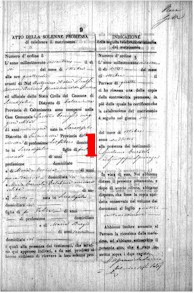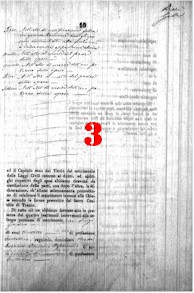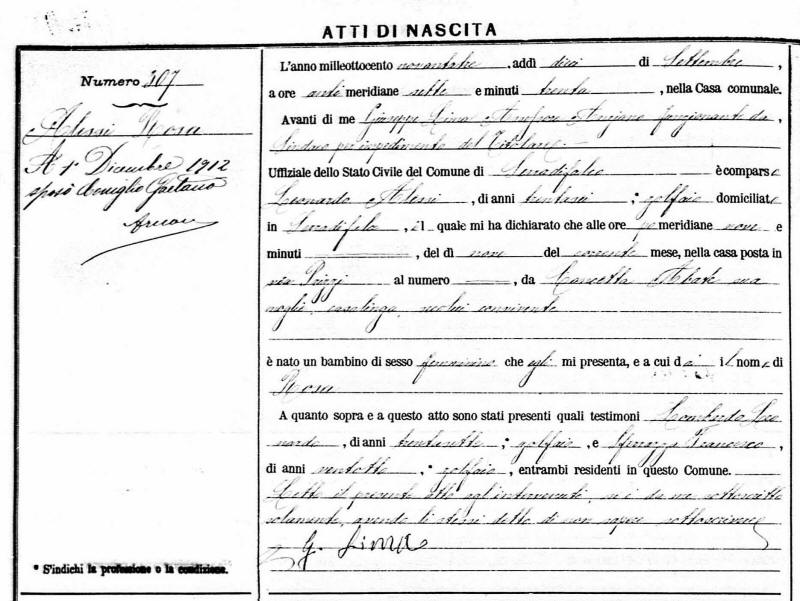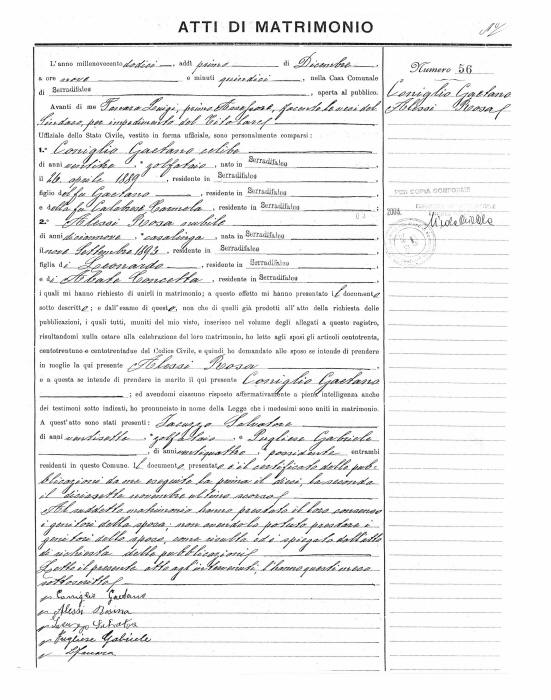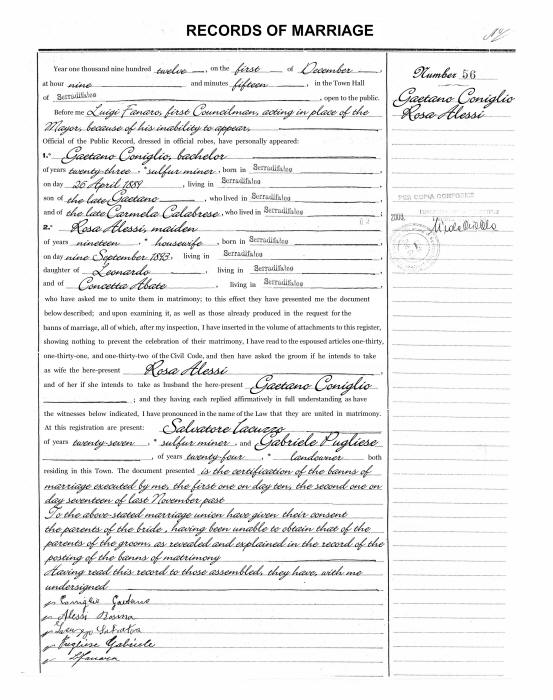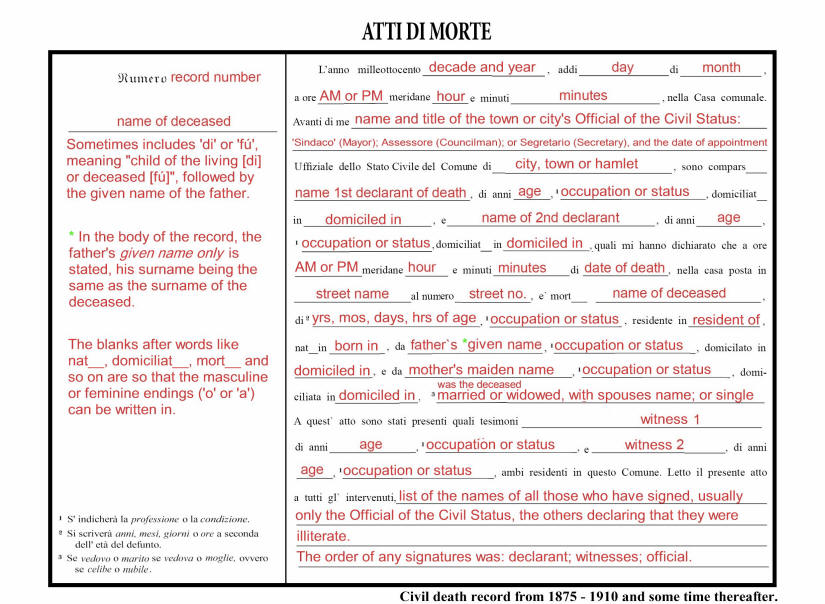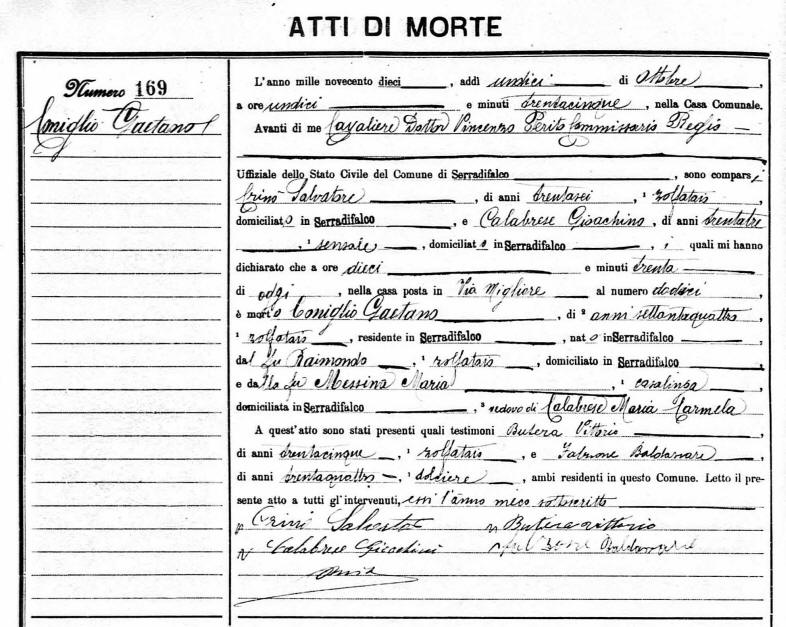|
|
Two types of
documents recorded the vital events in the lives of most Sicilians
from the early 19th through the 20th century: |
|
In the year 1816,
the Kingdom of Sicily, after internal and external political
machinations, re-formed as the Kingdom of the Two Sicilies (lu
Regnu di li Dui Sicilii). It comprised the same area as
its predecessor, namely
the present-day regions of Abruzzo, Molise, Campania, Napoli, Puglia,
Basilicata, Calabria, and the island of Sicily. |
|
The 1820 - 1865 records include 'Atti di Nascite' (Records of Birth), which have a section on the right of the document, entitled 'Indicazione del giorno in cui e stato amministrato il Sacramente del Battesimo' (Notice of the day on which the Sacrament of Baptism was administered). The right side is not the baptism record, but acknowledgement by civil authorities that they had been informed of the baptism and its date. The actual baptism record was retained in the church registers. Below is a template of the record type, followed by an example of a civil birth record from the period. In some cases the record was on one page; in other instances the same information was spread over the front and back of the same page. |
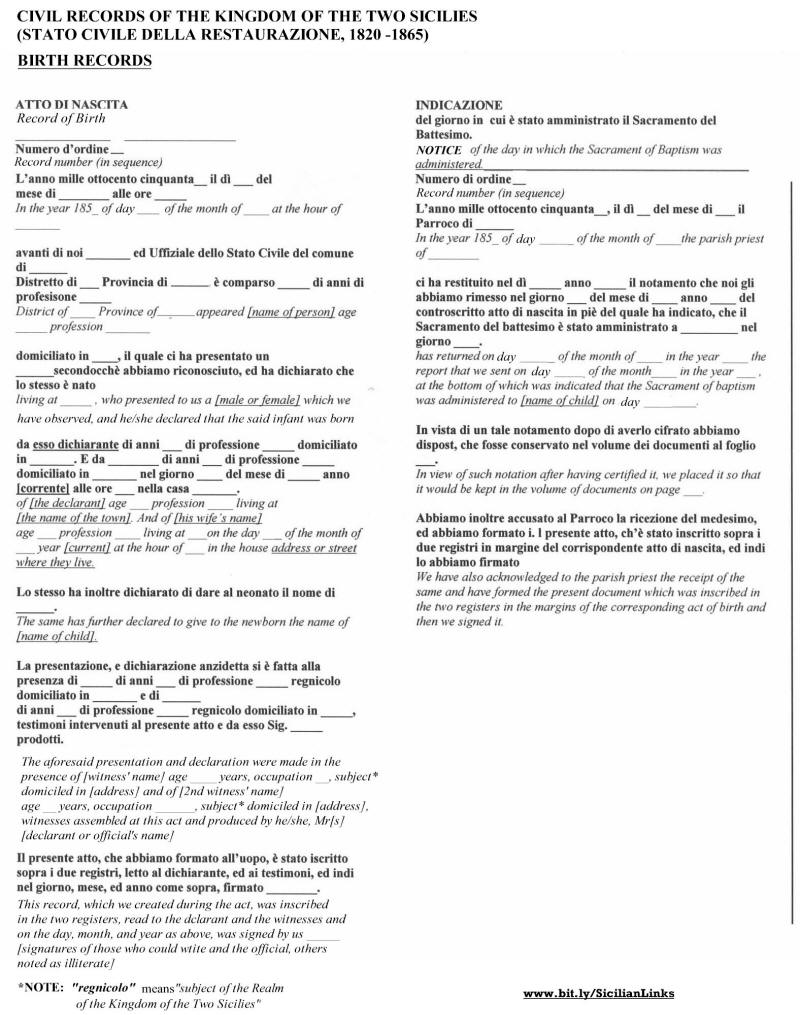 |
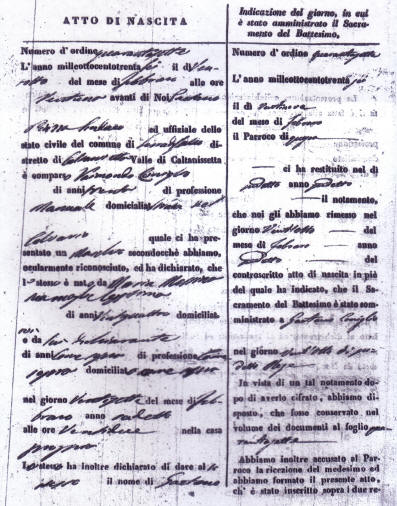 |
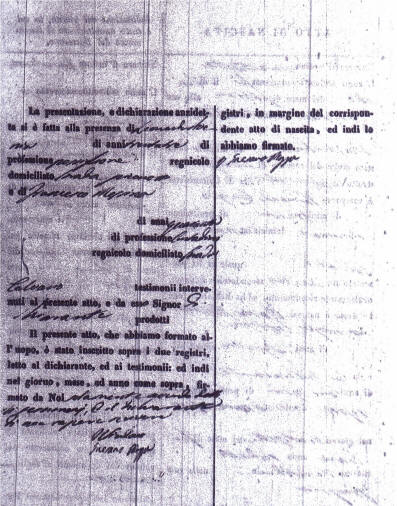 |
|
From Serradifalco Registri Stato Civile Film 1466430, 1836 Births, No. 47, Gaetano Coniglio |
|
. |
|
|
||
|
|
. |
|
The civil records from 1820 through 1865 include the 'Atto della Solenna Promessa di celebrare il matrimonio' (Record of the Solemn Promise to celebrate matrimony), with the right hand side entitled 'Indicazione della seguita celebrazione canonica del matrimonio' (Notice of the subsequent canonical celebration of matrimony). The left side is not a 'marriage record' but, essentially the record of a civil marriage contract. The right side is not the marriage record, but acknowledgement by civil authorities that they had been informed by the church of the actual canonical marriage, and its date. The canonical marriage record was retained in the church registers. A template for the marriage promise of the period, and an example of a civil record follow below. |
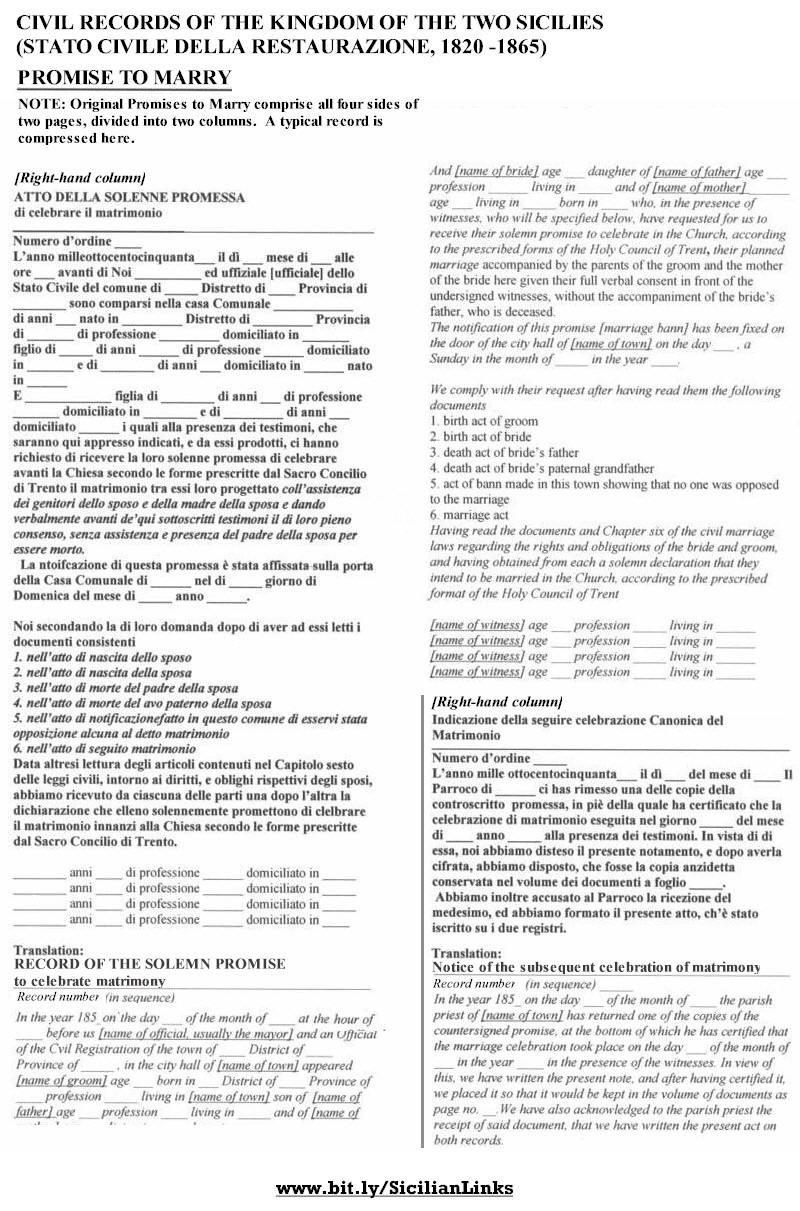 |
|
The civil records from 1820 through 1865 also include the 'Atto di Morte' (Record of Death). Death records rarely gave a cause of death, unless the death occurred in the military or in a hospital. Below is a template, followed by an example. |
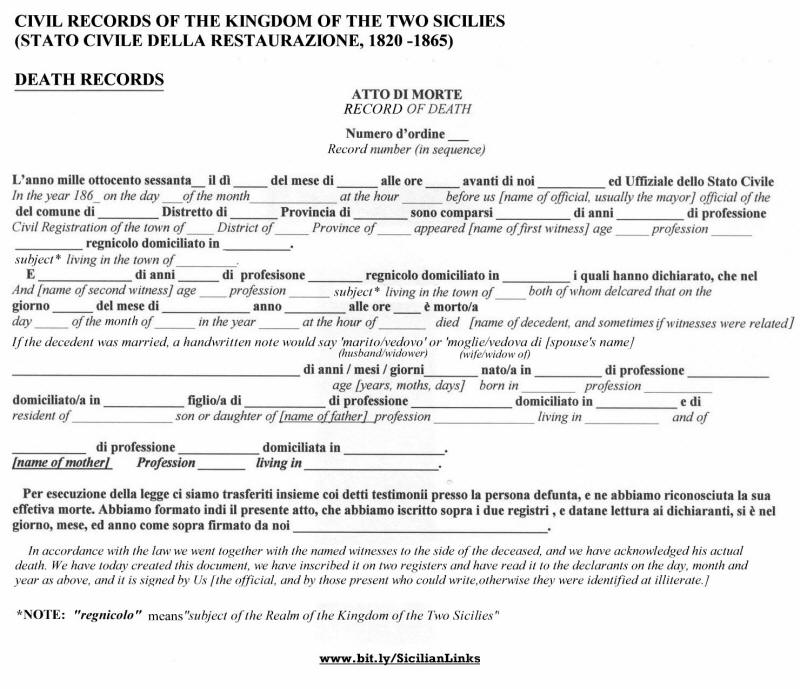 |
|
Note, the following death record is not the death record of the Gaetano Coniglio who is featured in the two records above, but the record of his father, Raimondo Coniglio. These records had no individual titles (i. e., 'Atto di Morte') and listed page numbers, but there is no relationship between the page number and the 'Numero di Ordine' (Record Number). Indices list record numbers, not page numbers. |
|
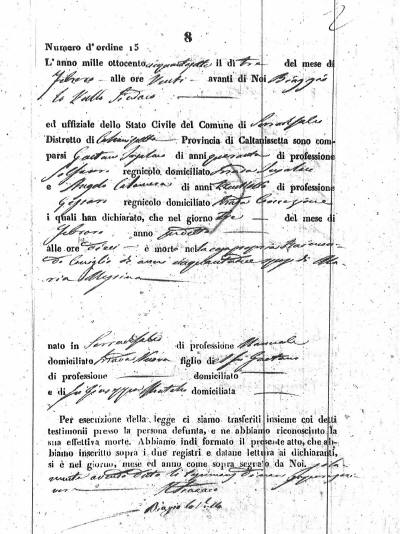 |
|
|
This translation is
factually correct.
|
|
After 1861, there was unrest lingering from the 'resorgimento',
which saw the Kingdom of the Two Sicilies subsumed with
several northern states into the Kingdom of Sardinia, which then
became the Kingdom of Italy. One of the results of the
'unification' was that the civil authorities of the new nation
appropriated most property of the nobility and the church and
disbursed it among opportunists and venture capitalists. |
|
In 1875, the church-civil schism still existed, and new pre-printed civil forms were instituted, without mention of church sacraments. The forms were in use at until 1910 (the last year in which microfilms were made of many towns' records) and beyond. These records are called records of the 'Stato Civile Italiano' (Italian Civil Status). The requirement begun in 1865, requiring civil ceremonies to legitimize marriages, still held, until the mid-1920's. |
|
Although they kept the general format, the new civil records of birth gave somewhat different information than in the previous years. The 1820 - 1865 records gave the age of the newborn's mother, the 1875 form usually omits it. The 1866 - 1874 handwritten records usually omitted it, but gave the names of the fathers of the infant's parents. Many birth records from every era had 'margin notes', indicating the later marriage, death, or change in the name of the principal. A template and an example of a birth record from the Stato Civile Italiano follow. |
|
The following are
several categories of Italian civil records as organized beginning in
1875. Note that the `series' and `parts' are generally only included if
there are records pertaining to those categories. For example, a set of
records might contain a full year of Series A, Part 1 documents, and two
or three Series B, Part 2 documents. Serie (Series) A: Parte (Part)1 - occurs in the comune (municipality) Parte 2 - occurs outside of their comune Serie B: Parte 1 - statements that occurred 10 days after birth Parte 2 - foundlings, acts of recognition or derecognition, changes or additions to a family name (note- births for
foundlings are often in the Parte 1 of the comune in which they
occurred) Parte 1 - officiated by the Uffiziale dello Stato Civile (Official of the Civil Status) Parte 2 A - officiated by a priest, who notifies the municipality, and if it is a different comune, they are transcribed in Parte 2 B Parte 2 C are
performed by a Civil official outside of the town hall; usually
performed for those in danger of imminent death. Parte 1 - occur in the comune Parte 2 A - occurs outside of the comune Parte 2 B - occurs (for example) in a hospital, prison, military or other institution Parte 2 C - occurs abroad --------------------------------------------- Auxiliary records, in general: Processetti (Procedures) are church records, so called because they were initially a "process" with witnesses for both the groom and the bride, as well as the testimony of a priest, to the faith of the couple and the fact that they did not have a previous marriage contract or promise of marriage before. He was required to view/gather all of the pertinent documents. Although they are church records, they often are included in civil archives. In more recent times the Allegati (Attachments) are equivalent to those of the Church, but for civil marriages, and contain acts of birth/baptism, deaths of previous spouses, etc. There are also Allegati for other types of records. |
|
|
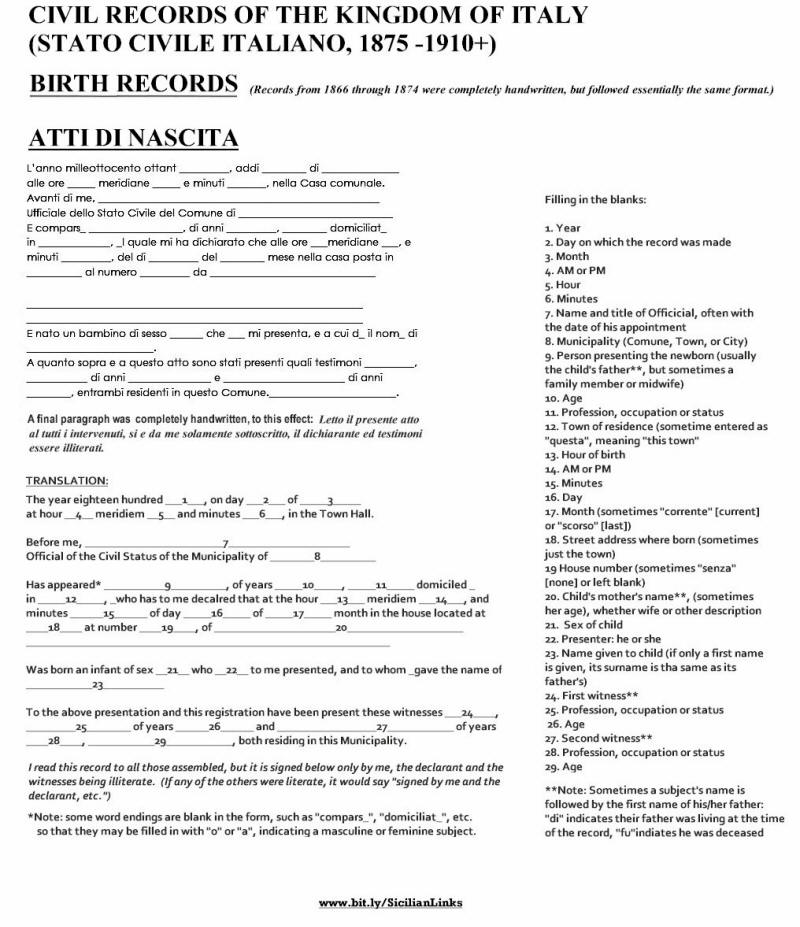 |
|
From Serradifalco Registri Stato Civile Film 1961310, 1893 Births, No. 307, Rosa Alessi |
|||||||
|
|
Starting with 1875, the Atti di Matrimonio, Parte Prima (Records of Matrimony, Part 1) were on pre-printed forms requiring the names, ages and occupations of the betrothed; the names of the parents of both and whether they were living; and the names of two witnesses. The civil record makes no mention of a church marriage. |
|
|
|
Example of Atti di Morte, Parte Prima (Records of Death, Part 1) from the Stato Civile Italiano. Like earlier death records, they generally gave no cause of death, nor any information about offspring. In all eras, the death records are generally the least reliable of civil records, since the declarants may not have known the deceased very well. The age of the deceased was usually estimated, and the names of the spouse and/or parents might be incorrect or even missing. If the deceased had been married more than once, sometimes the name of all spouses was given, but usually only the most recent spouse was named. Below is a template, followed by an example, the record of death of Gaetano Coniglio the elder, whose 1836 record of birth is the first example presented above. |
|
|
|
From Serradifalco Registri Stato Civile Film 1964373, 1910 Deaths, No. 169, Gaetano Coniglio |
|
|
|
|
| SICILIAN LINKS | Sicilianità | Is Sicily 'Italy'? | The Sicilian Languge | |||
| Cognomi ~ Sicilian Surname Origins | Ngiurii ~ Sicilian Nicknames | Place-names as surnames | Sicilian Coats of Arms | |||
| Foundlings | The Sicilian Naming Convention |
|
Convert Latin given names to Sicilian | |||
| La Bedda Sicilia ~ My history of Sicily | Heritage Path ~ original Sicilian records | Civil Record Format ~ 1820 - 1910 | I'm a Sicilian American | |||
| My Lectures on Sicilian Genealogy | Sicilian Occupations in Civil Records | Sicilian Records at the Buffalo FHC | Orphans, Illegitimates, and Foundlings | |||
| Li Carusi ~ The Mine-boys | Shortened Sicilian Given Names | There is no letter "j" in Sicilian | The Thing | |||
| Womens' Surnames | Masculine and Feminine Names |
